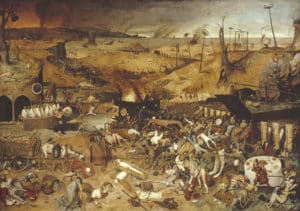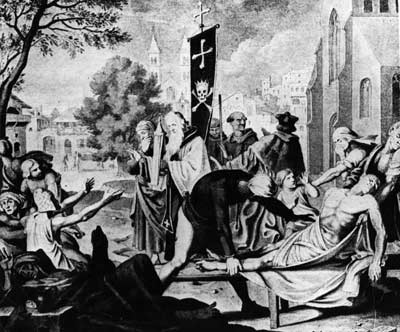No one was exempt as it swept in off the shores and into the countryside laying its burden of death and pestilence. Europe had prospered readily for about 300 years prior to the beginning of the 1300s, but a series of natural disasters occurred. Poor harvests and famine were common and as the prosperous years came to a close, economies were in recession at the onset of the Black Death. Europe, on a whole, would take a step backward.
There have been plagues throughout recorded history, but none were of the magnitude nor had the far reaching effects that the Black Plague had. Its namesake came from symptomatic hemorrhages that turned black. Though most people associate the Black Death with the middle ages, forms of the Bubonic Plague have been known in China as early as 224 BC. The Black Death embarked on a journey as an epidemic in the Gobi Desert in the 1320s. By 1400, China’s population of 125 million had been reduced to 90 million. Southwest Asia and Europe followed suite with strikingly similar losses in their population base. In 1347, the Kipchaks who were nomads from the Euro-Asian Steppe, were thought to deliberately infect a European city with the disease. The Kipchaks had laid siege to a Genoese trading post in Crimea. Hoping to weaken the defenders, they used a catapult to lob infected corpses into the compound. Trading vessels from Crimea subsequently brought cargo infested with the disease burdened rodents and crew west.
Plague had. Its namesake came from symptomatic hemorrhages that turned black. Though most people associate the Black Death with the middle ages, forms of the Bubonic Plague have been known in China as early as 224 BC. The Black Death embarked on a journey as an epidemic in the Gobi Desert in the 1320s. By 1400, China’s population of 125 million had been reduced to 90 million. Southwest Asia and Europe followed suite with strikingly similar losses in their population base. In 1347, the Kipchaks who were nomads from the Euro-Asian Steppe, were thought to deliberately infect a European city with the disease. The Kipchaks had laid siege to a Genoese trading post in Crimea. Hoping to weaken the defenders, they used a catapult to lob infected corpses into the compound. Trading vessels from Crimea subsequently brought cargo infested with the disease burdened rodents and crew west.
Starting in Sicily in 1347, it began a four year reign of terror traveling as far as Greenland. During this four year period it is believed Europe lost one full third of its population. The effects the Plague had on the economy and the laws governing the state were severe. England is a perfect example. By 1349, the population had been so severely decreased that the commoner had the upper-hand on the land-lords. This was significant in that they were able to demand a higher wage and the markedly increase in their mobility if one lord did not suit their needs. Without the manpower to cultivate and yield crops, the land-lords were in effect held without influence. The Parliament came to their rescue by imposing penalties and restricting the movement of the laborers and limits the wages. Although this was effective at the time and serf’s services continued, it resulted in a revolt some 30 years later. The end economic result of the Plague was somewhat surprising. Prices dropped and wages increased. The latter not so surprising.
Although not proven, the deflation of goods decreased because of a significant decrease in population. This gave rise to a new social relationship that would replace the status quo of centuries. A higher standard of living resulted for the lower class. Higher wages and a lower cost of living usually come with an opportunity of social advancement. By our standards, the advance was minimal, but considering the conditions of the time, it was considerable. The laws that the English Parliament had passed to govern the lower class were not only a sign of changing times, but proof that a new era and social class were emerging.
Much of the Christian religion we see today was shaped from views developed by society at that time. Various forms of religious behavior developed, but were far from what we recognize today. One of the most gruesome replications were the resurgence of Flagellants. The Flagellants were convinced that the end of the world was at hand and the Plague was the wrath of God. They traveled in organized bands, bound by vows to abstain from all physical pleasures and to endure tortures and whippings for 33 days, in memory of the 33 years of the life of Christ. In truth most Christians did believe the cause of the Plague was God’s wrath on a wicked Man. Many said they were doomed by their own wickedness. There were also others who believed themselves condemned and in today’s wording “Partied Hard” with the thought, since tomorrow we die, let us eat, drink, and be merry.
The Catholic Church was injured both physically and emotionally. In Avignon, this had been the home of the Papacy for nearly a century lost greater than half of its monks. Consequently, religious purity for the dying was hard to come by. This was not only a result of the priests trying to fulfill their duties and becoming infected, but also by those who sought to stay away. When recognizing what was happening around him, Pope Clement VI realized that nothing would be gained from his death and sought refuge in his chambers spending days sitting between two roaring fires on either side of him. One note of consolation to the medical field, was all this was done on the advice of the Papal physician. He survived as well as most of the upper class did by simply having the means to do so. People recognized the loss of the cleric alongside the peasant, lady of the court, and child. It did not distinguish evil from good, but took the lives of all. Overall there was a negative effect on the popularity of the church. A struggle between faith and reason developed giving rise to religious, social, and political unrest. Religious reformer John Wycliffe, in England and John Huss, in Bohemia were leaders of a couple of many sects that challenged Catholic Church’s behavior and doctrine. Although decades later, these complaints eventually led to the formation of the Protestant Church.
The state of medical knowledge had in truth, caused more harm than repair. The crucial role of rodents and fleas were never  identified until centuries later. Wild theories ranged from the blaming of Jews who were thought to be ritually poisoning wells to the belief that the sickness was carried on the warm, moist southerly breezes. Treatments included the practice of bleeding patients to release evil spirits. The wound more often resulted in another viscous opening for the disease to enter. One physician maintained that the disruptiveness of malodorous places such as latrines would drive the sickness away, while others maintained it was the cause. Bottom line, the only cure or better stated, the only defense was isolation based on medical knowledge at the time. Monarchs, Lords, Kings and even the Papacy were spared only through the revelation that being alone was the key to survival.
identified until centuries later. Wild theories ranged from the blaming of Jews who were thought to be ritually poisoning wells to the belief that the sickness was carried on the warm, moist southerly breezes. Treatments included the practice of bleeding patients to release evil spirits. The wound more often resulted in another viscous opening for the disease to enter. One physician maintained that the disruptiveness of malodorous places such as latrines would drive the sickness away, while others maintained it was the cause. Bottom line, the only cure or better stated, the only defense was isolation based on medical knowledge at the time. Monarchs, Lords, Kings and even the Papacy were spared only through the revelation that being alone was the key to survival.
Surprisingly, in all the references there was little to be found referring to the Arts and the beginning of the Renaissance Period. One volume of recommended reading titled Plague and Pestilence in Literature and Art, Raymond Crawfurd, Clarendon Press, 1914 was referenced, but was not available. Undoubtedly, there were effects that were negative and positive. Negative in meaning that the depiction of death became more morbid after the Plague. A fair example can be found on a wall of the cemetery close to Camposanto (Pisa Cathedral) in Pisa. Like Pieter Bruegel, The Elder’s painting, “Triumph of Death”, 1562 (attached), this fresco by Francesco Traini, is also called “Triumph of Death”, 1350 (Roy T. Matthew and F. DeWitt Platt, The Western Humanities, Second Edition, Mayfield Publishing Company, 1994). Death relinquished its identity as an intangible skeleton, to become a vision of the macabre. A black flowing shroud with a scythe for gathering souls. Death no longer took on the stately representation of regalia worn by knights and ladies of the court. Post-Black Death art during the Renaissance also depicts a higher moral standard. For example, Giovanni del Biondo’s vision of John the Evangelist, renders him overwhelming Avarice, Pride, and Vain-glory. The direct effect the Plague had was to clear away the blurring veils where Gothic Art had taken a foothold. Humanity was brought back to earth by their own mortality. The Renaissance was a reawakening, resurrection, or renewal of reality showing life in a more pragmatic nature. The Plague still maintains its identity today. Cases are still reported throughout the world. Thankfully, rarely in North America. Mortality has dropped from the 70 to 90% experienced in the 14th century to 3 to 5 % today. The loss of life in those four short years of history was immense. A plague of the proportions that struck Europe would be compared to the effects of a nuclear war today. A thought that chills my bones to the core. Just imagine how a government of today’s society would react to a disease with no cure that spread with the same rapidity and executed with the same effectiveness. The answer lies just one unknown virus away in our own evolution cycle.
BIBLIOGRAPHY
Zeigler, Philip, The Black Death, John Day Company, New York, 1969
McNeill, William H., Plagues and Peoples, Anchor Press/Doubleday, 1976
Mee, Charles L, How a Mysterious Disease Laid Low Europe’s Masses ,
Smithsonian,. 1990
Canning, John, 100 Great Events That Changed the World, Hawthorn Books, 1966
Strayer, Joseph I., Dictionary of the Middle Ages, Reese, 1904
Magill, Frank N., Great Events From History: Ancient and Medieval Series,
Salem Press, 1972
Microsoft Encarta 95, Microsoft Corporation, 1994
Roy T. Matthew and F. DeWitt Platt, The Western Humanities, Second Edition, Mayfield Publishing Company, 1994
